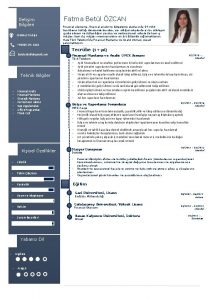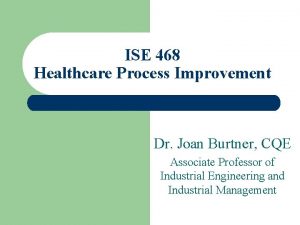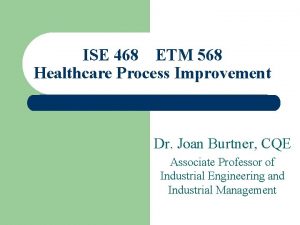Ozcan Chapter 9 Productivity ISE 468 Spring 2013









- Slides: 9

Ozcan: Chapter 9 Productivity ISE 468 Spring 2013 Dr. Joan Burtner

Outline q q q q q Productivity Improvement Trends in Healthcare Productivity: Consequences of Medicare Prospective Payment System (PPS) Productivity Definitions and Measurements Ø Productivity Benchmarking Ø Multifactor Productivity Commonly Used Productivity Ratios: Hours per Patient Day or Visit Adjustment for Inputs Ø Skill-Mix Adjustment to Worked Hours Ø Cost of Labor Adjustments for Output Measures : Service/Case-Mix Adjustments Productivity Measures Using Direct Care Hours Productivity – Quality Relationship Productivity Dilemmas Multiple Dimensions of Productivity: Data Envelopment Analysis(DEA) ISE 491 Spring 2013 Dr. Burtner Ozcan Chapter 9 Productivity Slide 2

Improving Healthcare Productivity 1. Develop productivity measures for all operations in their organization. 2. Look at the system as a whole (do not sub-optimize) in deciding on which operations/procedures to focus productivity improvements. 3. Develop methods for achieving productivity improvements, and especially benchmarking by studying peer healthcare providers that have increased productivity; and reengineer care delivery and business processes. 4. Establish reasonable and attainable standards and improvement goals. 5. Consider incentives to reward workers for contributions and to demonstrate management’s support of productivity improvements. 6. Measure and publicize improvements. ISE 491 Spring 2013 Dr. Burtner Ozcan Chapter 9 Productivity Slide 3

Trends in Productivity: Consequences of PPS • The recent decades’ changes in reimbursement strategies aimed to end waste and promote innovative and cost-efficient delivery systems. • Productivity gains from the Prospective Payment System (PPS) have not materialized to the extent predicted. • Hospitals now employ more people to treat fewer patients, and the increase is not accounted for by the greater severity of patient illness in the late 1980 s and in 1990 s. • Although employers, insurers and public are spending less on inpatient care, the rising use of outpatient procedures has simply increased costs in that area which counters the savings (Altman, Goldberger, and Crane, 1990). ISE 491 Spring 2013 Dr. Burtner Ozcan Chapter 9 Productivity Slide 4

Trends in Productivity: Consequences of PPS • The constraints that force healthcare institutions into the role of cost centers, coupled with shifting patterns of inpatient acuity, tight healthcare labor markets, and society's expectations of high quality of care leading healthcare organizations to a "productivity wall. " When the wall is reached, it is quality of care that inevitably is sacrificed for the sake of productivity and profit (Kirk, 1990). • It must be recognized that there are limits to ratcheting up productivity. • It is not always possible to do more with less. ISE 491 Spring 2013 Dr. Burtner Ozcan Chapter 9 Productivity Slide 5

Productivity Definitions and Measurements q Productivity is one measure of the effective use of resources within an organization, industry, or nation. q The classical productivity definition measures outputs relative to the inputs needed to produce them. That is, productivity is defined as the number of output units per unit of input. ISE 491 Spring 2013 Dr. Burtner Ozcan Chapter 9 Productivity Slide 6

Productivity Definitions and Measurements • Sometimes, an inverse calculation is used that measures inputs per unit of output. Care must be taken to interpret this inverse calculation appropriately; the greater the number of units of input per unit of output, the lower the productivity. • For example, traditionally productivity in hospital nursing units has been measured by hours per patient day (HPPD). That requires an inversion of the typical calculations: meaning total hours are divided by total patient days. ISE 491 Spring 2013 Dr. Burtner Ozcan Chapter 9 Productivity Slide 7

Example 9. 1 Nurses in Unit A worked collectively a total of 25 hours to treat a patient who stayed 5 days, and nurses in Unit B worked a total of 16 hours to treat a patient who stayed 4 days. Calculate which of the two similar hospital nursing units is more productive. Since the HPPD productivity ratio is expressed as input over output, lower is better. Unit B productivity is better than Unit A. ISE 491 Spring 2013 Dr. Burtner Ozcan Chapter 9 Productivity Slide 8

Productivity Definitions and Measurements • Productivity Benchmarking. Productivity must be considered as a relative measure; the calculated ratio should be either compared to a similar unit, or compared to the productivity ratio of the same unit in previous years. Such comparisons characterize benchmarking. Many organizations use benchmarking to help set the direction for change. • Historical Benchmarking is monitoring an operational units’ own productivity or performance over the last few years. Another way of benchmarking is to identify the best practices (best productivity ratios of similar units) across health organizations and incorporate them in one’s own. ISE 491 Spring 2013 Dr. Burtner Ozcan Chapter 9 Productivity Slide 9

















